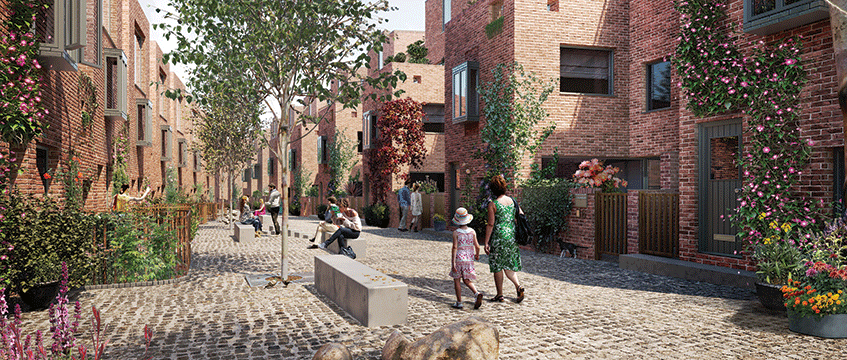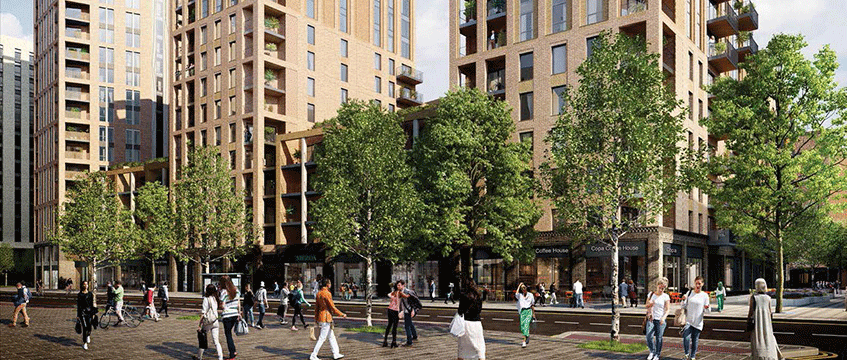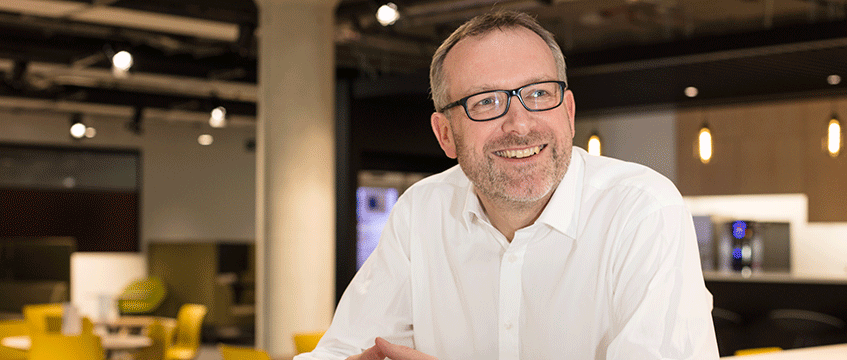When Graeme Craig took on the role of Transport for London’s commercial development director in 2012, much of the job centred on the seemingly mundane task of keeping its network of car parks ticking over.
“When I started the role in commercial development the joke was I only did it on a temporary, part-time basis,” Craig says. “Initially the job was to continue running TfL’s car parks… We didn’t know what we owned back then, and we certainly didn’t have a strategy for making the most of it.”
Since then, Craig and TfL have been on a journey of self-discovery, and Craig’s current role – his latest in more than 15 years with TfL – sees the no-nonsense Scotsman responsible for maximising the value of property across TfL’s entire 5,700-acre estate, one of the largest in the capital.
Where the organisation once focused on selling off land and assets for an instant cash hit that it could reinvest back into the business, managers at TfL have shifted their mindset when it comes to property, taking a more long-term approach to generating revenue.
They have also plotted an ambitious property strategy, not least grand plans to start work on sites with the capacity to build 10,000 homes by March 2021 and bring forward more than 2.4m sq ft of space to the market for commercial development.
“This is not the organisation that we might have been in the past,” Craig says. “This is an organisation that squarely recognises the value [of property].”
Affordable housing: constraint or opportunity?
TfL grabbed the attention of the London property market in 2013 when it announced it was in advanced talks with Capital & Counties to invest in the £8bn Earls Court regeneration.
The Earls Court Partnership joint venture was approved in March 2014, with Capco owning 63% and TfL 37% of shares in the first phases of the 35-acre site that it would jointly develop.
The same month, TfL announced it would explore options to expand its property team and use its portfolio to drive growth. A year later, it announced it was hunting for partners to help redevelop 500 sites, hiring former Landsec chief executive Francis Salway to lead the search.
More than 50 developers expressed an interest and in February 2016, 13 were named in the Property Partnership Framework. The framework’s purpose was to help TfL develop an initial 50 of the 500 sites, building 10,000 homes on 300 acres of land.
At the time, Craig described the move as “a major step forward in allowing us to work with leading private sector developers and housing associations on an important part of our portfolio”.
But by May 2016, these plans looked like they could be in jeopardy.
Following his election as London mayor, Sadiq Khan announced a goal that 50% of new housing should be affordable for people on average incomes, sparking doubt by some sitting on the PPF about whether the public body could now meet its ambitious plans.
How has TfL managed to juggle Khan’s demands with its own development plans? “Our target, which we are hitting and will continue to hit, is 50% affordable,” says Craig. “We’re achieving it.”
Instead of viewing Khan’s affordable housing targets as a constraint, Craig says TfL has incorporated this into its business strategy. In fact, whether or not senior managers get paid a bonus at the end of the year is, in part, dependent on whether the organisation is meeting its affordable housing targets.
“When it comes to affordable housing, it shouldn’t be something that’s imposed on us,” Craig says. “London needs affordable homes. We’re in a position to bring these forward.”
However, TfL has a slightly lower affordable housing target for its build-to-rent developments.
Alongside its BTR partner Grainger, which it picked in April this year, TfL will build and manage 3,000 new rental homes in London, 40% of which will be affordable.
The partnership is 49% owned by TfL and 51% owned by Grainger. And Craig says his long-term plan is for the organisation to become the largest landlord of its kind in the capital.
It makes sense for Craig to give BTR an important role in TfL’s property strategy. According to a recent report from CBRE, investment into the UK’s BTR or multifamily market rose by 20% in the first half of 2019 compared with the same period last year. Two-thirds of investment volumes were in London developments, accounting for £232.6m.
“There’s huge demand for it,” Craig says. “Clearly there is increasing investment coming into the market in London for build-to-rent, and build-to-rent generates long-term revenue for us, which is the target.”
Questions over Crossrail
The PPF and deal with Grainger are just two of the initiatives launched by TfL under Craig’s watch in an attempt to diversify its approach to its property assets and maximise the value of its portfolio. The organisation has also revealed the second part of the Greater London Authority’s London Development Panel and launched a programme under which smaller developers can take on schemes of up to 100 homes.
This variety has helped “de-risk the programme”, according to Craig. But could one increasingly problematic project in TfL’s infrastructure division unravel the plans?
Following the high-profile delays to the Crossrail trainline last year, which resulted in the resignation of project chairman Sir Terry Morgan, doubts have been cast over whether its successor project, Crossrail 2, will go ahead.
What will it mean for the land that TfL has earmarked for development off the back of Crossrail 2 if the government shelves the project? Craig is adamant it will have no effect.
“Individual decisions on an annual basis as to where investment goes don’t particularly influence our programme,” Craig says. “You’re continually wrestling with which projects are taking place in which order, but either way, we continue to push developments. We’re absolutely never going to be in the position in which we simply sit on a site.”
He says that land developed off the back of Crossrail consisted of “very constrained work sites”, usually above the new stations along the line. If Crossrail 2 goes ahead, he adds, a different approach to development will be taken whereby he envisages TfL will look to work with adjoining landowners “in order to reimagine those parts of London, whether it’s Wimbledon or Victoria or Tottenham or anywhere along the line”.

“Continually for us, over time, it’s about how do we take the experience that we’ve got and look to work with other partners, whether they’re in the private or the public sector where, on a side-by-side basis, we share the proceeds and take a wider development perspective.”
Craig might not be losing sleep over Crossrail 2, but Brexit, on the other hand, could prove a cause for concern. So far, he says, the Brexit effect has been less than he would once have expected. “But the market is thinner.”
However, he is confident in TfL’s portfolio. “If you think about mid-market BTR […] whatever happens, from a Brexit point of view, I would be confident that we have a marketable product that we will be able to let.”
Commercial property plans
Alongside its housing plans, TfL’s property portfolio also plays an important role.
TfL has identified seven sites that it plans to bring to market for development, totalling roughly 2.4m sq ft of commercial space.
Two sites have already been announced but Craig is tight-lipped on the other five. TfL has already picked a jv between U+I and Notting Hill Housing as the developer for the first of its sites, Landmark Court, on Southwark Street, SE1. The second site is the Southwark Over Station Development, which is the area bound by Blackfriars Road, The Cut, Hatfields and Isabella Street.
The commercial property team is now in the process of identifying how to present the opportunities, Craig explains.
“What we haven’t done yet is decide whether we are bringing them out as a single package or bringing these things forward as joint ventures,” he says. “There’s a lot for us to work through.”
Bringing forward commercial developments will play an important part in boosting TfL’s balance sheet but Craig is adamant that his thinking goes beyond money. Creating the right kind of mixed-use regeneration around the city’s stations is essential to developing lasting landmarks for Londoners.
“This is not about how we build homes next to stations for people to get an early train into work and a late train home,” he says. “If we’re talking about legacy, we cannot just be creating dormitories next to stations for people, because that clearly wouldn’t be the right answer.
“We’re setting high standards for ourselves. We need to reflect the fact that London is not one homogeneous mass. It’s a whole variety of individual villages and towns and cities, and we need to come up with an answer that’s appropriate for that area.”
Doing things differently
Craig has played a fundamental role in transforming the way TfL operates as a quasi-infrastructure property business.
The organisation has come a long way from the days when managers couldn’t be sure of what land it owned.
Looking back over his time, what would he do differently? Furrowing his brow, Craig leans back in his chair and pauses for thought. He discusses TfL’s historical ethos of selling off its land and assets for cash and says he “despairs at some of the decisions that might have been taken in the past”, then quickly adds: “That’s easy for me to do sat here now.”
But he’s pleased with the progress that has been made and is looking forward to the challenges ahead. “I think for me and the people in the team, we’ve got an opportunity we will never have again in our working lives to change the city and the industry that we enjoy. I think I’ve got one of the best jobs in London.”

To send feedback, e-mail lucy.alderson@egi.co.uk or tweet @LucyAJourno or @estatesgazette











